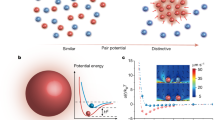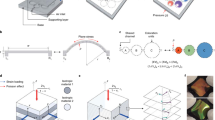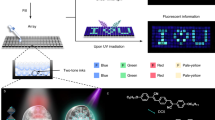Abstract
LIQUID crystals are organic compounds in a state of matter intermediate between the isotropic liquid and crystaline solid. They are fluid but at the same time they exhibit molecular order. Depending on the ordering one distinguishes the smectic, the nematic and the cholesteric liquid crystals1 (CLC). In the latter, the rod-like molecules are arranged in layers with their long axes parallel to each other. In each successive layer the direction of the long axis is rotated by an angle of 10–20 arc min; the molecules then form a helical structure. The spacing between layers differing by an angle of 360° is called the pitch, p. Due to the periodicity of molecular orientation, reflections from all layers separated by p/2 interfere constructively2, if the reflected wavelengths equal the product of the pitch and the refractive indices seen by the wave. This condition is met for a band of wavelength that is relatively narrow and steep and appears as a highly saturated colour2,3. The width of the band equals the product of the pitch and the difference of the two refractive indices of birefringence. Colours produced by such constructive interference, sometimes described as irridescent colours, have also been observed in certain beetles, birds and butterflies4. We report here results of experiments showing that colours of superimposed CLC coatings add like coloured lights and produce a colour gamut greater than that obtained with inks, dyes and pigments.
This is a preview of subscription content, access via your institution
Access options
Subscribe to this journal
Receive 51 print issues and online access
$199.00 per year
only $3.90 per issue
Buy this article
- Purchase on Springer Link
- Instant access to full article PDF
Prices may be subject to local taxes which are calculated during checkout
Similar content being viewed by others
References
Freidel, G. Ann. Physique 18, 273–474 (1922).
Ferguson, J. L. Mol. Cryst. Liq. Cryst. 1, 293–307 (1966).
Brown, G. H. Advances in Liquid Crystals (Academic, New York, 1976).
Wright, W. D. The Rays are not Coloured (Adam Hilger, London, 1967).
Stump, F. thesis, Univ. Gottingen (1911).
Wyszecki, G. & Stiles, W. G. Color Science (Wiley, New York, 1967).
MacAdam, D. L. J. opt. Soc. Am. 25, 249–360, 361–370 (1935).
Kelly, K. L., Gibson, K. S. & Nickerson, D. J. opt. Soc. Am. 33, 355–376 (1943).
Author information
Authors and Affiliations
Rights and permissions
About this article
Cite this article
MAKOW, D., SANDERS, C. Additive colour properties and colour gamut of cholesteric liquid crystals. Nature 276, 48–50 (1978). https://doi.org/10.1038/276048a0
Received:
Accepted:
Issue Date:
DOI: https://doi.org/10.1038/276048a0
This article is cited by
-
Dynamically actuated soft heliconical architecture via frequency of electric fields
Nature Communications (2022)
-
Cholesteric liquid crystal paints: in situ photopolymerization of helicoidally stacked multilayer nanostructures for flexible broadband mirrors
NPG Asia Materials (2018)
-
Controlled Encapsulation of Cholesteric Liquid Crystals Using Emulsion Templates
Macromolecular Research (2018)
-
Digital particle image thermometry/velocimetry: a review
Experiments in Fluids (2009)
Comments
By submitting a comment you agree to abide by our Terms and Community Guidelines. If you find something abusive or that does not comply with our terms or guidelines please flag it as inappropriate.



